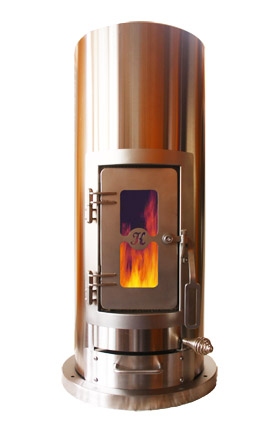The Triangle of Fire is what I'm calling my three needs for heat: heating the house, cooking and heating water. The Kimberly wood stove will at least partially meet all three needs, with some backup.

A few weeks ago I spent an hour talking with Roger Lehet, inventor of the amazing Kimberly stove, about how best to install it in my home. The Kimberly is different from other stoves in all sorts of fascinating ways. It's little, powerful, captures and burns the gasses that burning wood releases, making it hyper-efficient and virtually smokeless, and less is more, meaning that a few sticks burn a nice hot fire better than a big load of wood. And it can do tricks, too! There's a thermo-electric generator on the way that will charge batteries and heat water. It won't be ready til sometime next year, but I have other options in the meantime.
| It weighs only 56 pounds, is 10 inches wide, and needs only 6 inches of clearance on each side of it, so it fits in small spaces. When the Kimberly wood stove is dampered down, the fuel stays at close to 450-degrees as it burns, creating massive amounts of smoky gases. As they rise to the top of the combustion chamber they ignite and burn at a super high temperature. Most of the heat produced in the Kimberly comes from that second fire, which produces a very efficient and clean burn, with very little smoke emitting from the chimney. Today I spoke with Shane Clarke at Tegpro, who make Devil Watt thermo-electric generators for wood stoves. They use temperature differences to generate electricity, and the water that runs through the generator to cool it gets nice and hot, and can be used to bathe, or wash dishes or clothing. They're finishing up development of a generator model for the Katydid stove, the big sister of the Kimberly. Once it's all done, they'll begin adapting it to the Kimberly. In the meantime, I'll design my plumbing system to be compatible with it. One thing the system needs is what's called a dump zone--a way to distribute the heat so that the water doesn't overheat. Often people runt he pipes back and forth to make a radiator. My plan is to run the pipes through my tiny greenhouse, to keep my tropical plants happy. Stay tuned as I figure out my cooking options. |  |
 RSS Feed
RSS Feed